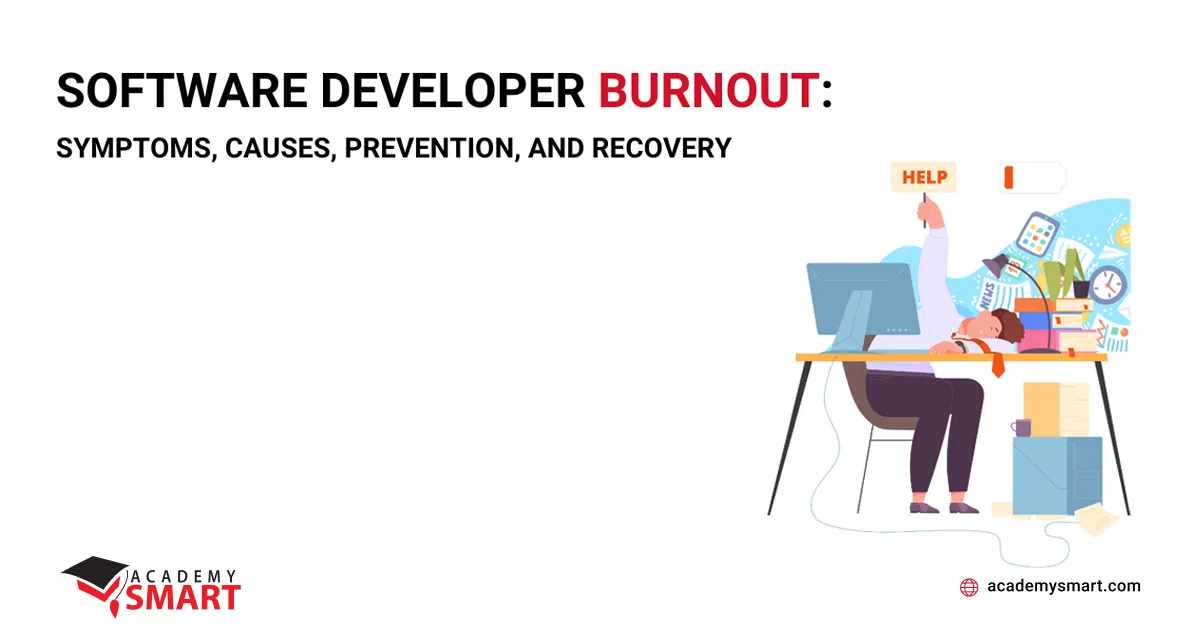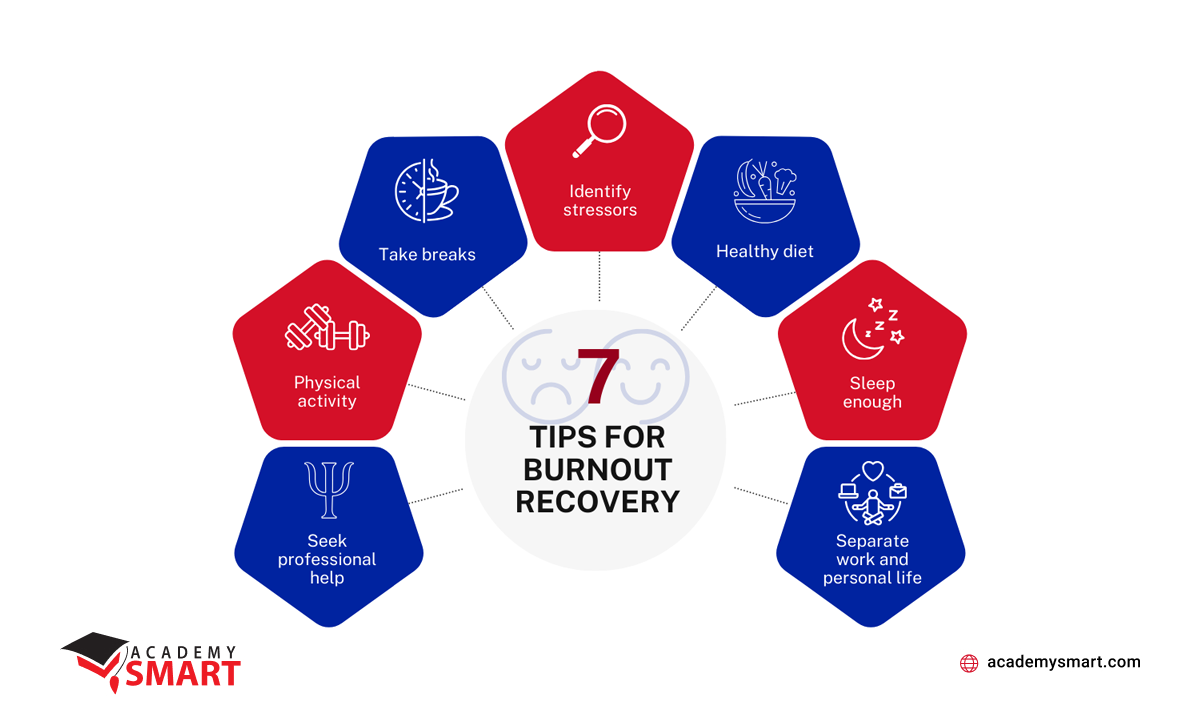
Software Developer Burnout: Symptoms, Causes, Prevention, and Recovery
Contents
The software development industry is known for its remarkable career prospects and financial rewards. The nature of this work attracts individuals who thrive on solving complex problems and high productivity. Still, it also makes them susceptible to regular emotional pressure points they often underestimate. As a result, many IT professionals experience software engineer burnout, and the problem is much deeper than it might seem at first glance.
This article will delve into the signs, causes, and remedies for programmer burnout. It will help you equip yourself with the knowledge and tools to preserve your passion for programming and ensure a long and fulfilling career in IT.
What is Software Engineering Burnout
Software developer burnout is a pervasive and debilitating condition resulting from chronic workplace stress that remains unmanaged. This phenomenon affects individuals across various professions, with software engineers being particularly susceptible due to the disposition of their work. The digital age, characterized by extensive connectivity and remote work, has only exacerbated the issue.
While stress can contribute to engineering burnout, they are not synonymous. Stress typically involves managing the pressures and demands of daily tasks, with individuals striving to cope and complete their work. In contrast, computer burnout goes beyond mere stress; it reflects a state of chronic exhaustion where individuals may give up hope of overcoming the tension. It leads to a pervasive physical, emotional, and mental depletion.
Burnout is a severe and chronic state that, if left untreated, can profoundly affect an individual’s well-being, job performance, and overall quality of life. It is essential to recognize the signs early, seek support, and take steps to prevent or address burnout in the software development industry.
The symptoms of software engineer burnout manifest in diverse ways, and individuals may experience them differently. Common programmer burnout signatures include:
- Emotional and mental tiredness
Burnout often begins with feelings of chronic physical and mental fatigue. This exhaustion may lead to emotional detachment from one’s work and colleagues. - Lack of motivation
A significant sign of burnout is the loss of enthusiasm for tasks that were once engaging and fulfilling. That can result in decreased productivity and the inability to focus on work. - Physical symptoms
Physical health is impacted, with individuals experiencing insomnia and a weakened immune system. That can lead to frequent illnesses and the appearance of obesity, high blood pressure, and high cholesterol. - Changes in appetite
Burnout may cause individuals to skip meals or lose their appetite, leading to unintended weight loss. - Psychosomatic reactions
Burnout is associated with psychosomatic responses, including elevated blood sugar levels, cerebrovascular disorders, and increased use of sedatives, cigarettes, and alcohol. - Emotional distress
Emotional symptoms include depression, emotional emptiness, a sense of losing meaning in life, anxiety, apathy, social withdrawal, and feelings of worthlessness and helplessness. - Behavioral changes
Burnout can result in changes in behavior, such as difficulty concentrating, forgetfulness, increased irritability, rudeness, heightened sensitivity to external influences, negative attitudes towards work and colleagues, interpersonal conflicts, and issues in personal relationships.
Causes of developer burnout
To understand the scale of this problem and realize that it is inherent in many software engineers, both men and women, regardless of age and narrow programming specialization, let’s get acquainted with statistics for American software developer burnout:
Recent Gallup surveys indicate that approximately 76% of workers, including software coders, report experiencing burnout. The tech industry, including software application development, is especially prone to burnout due to high-pressure work environments, fast-paced projects, and often unrealistic deadlines. Unsurprisingly, data show that 83% of software developers experience burnout at work. High workloads (47%) are the leading cause of burnout among coders, but inefficient processes (31%) and unclear goals and targets (29%) are also significant contributors. At last, the sudden shift to remote work during the COVID-19 pandemic has posed challenges in maintaining work-life balance for software developers, as complex scientific research demonstrates. Remote work has led to increased digital distractions, compounding overwhelmed feelings.
Developer burnout is a prevalent issue that can be attributed to external and internal factors. Understanding these causes is essential for detecting and avoiding burnout effectively. Here are the primary causes:
- High workload
Developers often face intense workloads with too high expectations and tight deadlines. Long working hours, including nights and weekends, are typical, leading to chronic stress and exhaustion. - Lack of autonomy
Developers may feel detached from the decision-making process, leading to a sense of powerlessness. Fulfilling ineffective tools and workflows can contribute to frustration and disengagement. - Monotony
Repeatedly working on the same tasks or coding the same features can lead to boredom and stagnation. A lack of opportunities for personal growth and learning new skills can also contribute to burnout. - Bad project management
Unrealistic project timelines, inadequate planning, and poor estimates can lead to work overload and heightened stress. Pressure to meet impossible goals, both in quantity and quality of work, is a significant factor. - Poor workplace culture
Toxic working environments marked by bullying, harassment, and poor communication can erode mental health. The absence of constructive feedback, recognition, or opportunities for professional development can create additional stress. - Value conflicts
A mismatch between individual values and the organization’s mission can lead to internal conflict and chronic stress. Developers may struggle when their personal principles clash with their company’s goals. - Lifestyle restrictions
Lack of social interaction, unhealthy habits (e.g., sitting for extended periods), inadequate sleep, and a sense of limited opportunities can exacerbate burnout. - Personality traits
Innate qualities like perfectionism, over-commitment, difficulty setting boundaries, and a strong need for recognition can increase susceptibility to burnout. - Ego and self-image
Narcissistic omnipotence and a solid attachment to self-image can lead to burnout, as individuals may overextend themselves to maintain a particular image. Burnout has been linked to negative self-assessment, reflecting its psychological dimension.
Despite the broad prospects that obtaining a job in the IT field opens up, it is crucial to soberly assess the specifics of the work of a software developer and the upcoming mental and psychological stress inherent. Otherwise, high anticipations and daily difficulties will quickly result in profound disappointment in abilities. It’s important to note that burnout doesn’t occur suddenly; it develops gradually over time. Recognizing the signs of burnout early and taking proactive measures to address these causes are crucial for maintaining the well-being and productivity of software developers.
Risks and impacts of programming burnout
Software developer burnout, a pervasive problem in the IT industry, carries significant risks and far-reaching impacts, affecting individuals and organizations.
In case of burnout, an individual faces with:
- Health problems
Burnout takes a heavy toll on an individual’s health. The chronic stress, anxiety, and relentless pressure associated with it can result in various physical and mental health issues. - Decreased productivity
Burnout significantly impairs an individual’s ability to function effectively. As exhaustion and disengagement take hold, developers find it increasingly difficult to focus on their tasks. It reduces productivity, subpar work quality, and a heightened risk of missing project deadlines. The inability to meet professional expectations often exacerbates burnout. - Job dissatisfaction
Developers who experience burnout often have a negative perception of their roles. What was once a source of passion and creativity becomes a relentless source of frustration. The joy of coding and problem-solving diminishes, replaced by feelings of burden and job dissatisfaction. - Increased absenteeism
Burnout results in increased absenteeism as developers take more sick days to recover from physical and mental health issues. These extended absences put additional pressure on the remaining team members, causing further project timelines and workload disruptions.
At the same time, for a business, problems with burnout of its employees imply additional costs and other challenges:
- High turnover rates
Burnout is a leading cause of high turnover in companies. Burnt-out developers are more likely to seek alternative employment opportunities, leading to a revolving door of talent. This constant turnover increases recruitment and training costs and disrupts team continuity. - Decreased morale
The presence of burnout among team members can significantly impact overall morale. Colleagues witnessing peers struggling with stress and dissatisfaction can lead to a tense atmosphere within the workplace. That discourages existing employees and deters potential talent from joining the organization. - Missed deadlines
Developer burnout is a primary contributor to missed project deadlines. Project timelines are extended due to decreased productivity and disengagement. These delays affect the timely delivery of products or features to clients and customers, potentially damaging the organization’s reputation. - Reduced innovation
Burnout stifles creativity and innovative thinking. Developers becoming disengaged and unmotivated are less likely to explore new approaches, technologies, or solutions. It impacts the organization’s ability to innovate and remain competitive.
In summary, programming burnout represents a multifaceted challenge with profound implications for individual developers and their enterprises. Prioritizing strategies to mitigate burnout, including fostering a supportive work environment, promoting work-life balance, and offering mental health resources, is essential to minimize the considerable risks.
How to Prevent Programmer Burnout Depression
As you understand, the occurrence of this problem is much easier to prevent than to eliminate its consequences, especially in the chronic stage. To maintain your well-being and avoid software engineer burnout, consider the following strategies:
- Recognize the signs
The syndrome typically starts with losing enthusiasm for your work, decreased motivation, and helplessness. It’s essential to recognize them early, pay attention, and study available articles or books on programmer burnout to understand what is happening. - Take regular breaks
Prioritize self-care by taking breaks when needed. Consider taking a few weeks off to recharge rather than forcing yourself to continue working while feeling burnt out. Engage in hobbies and activities you enjoy during your break. - Set realistic goals
Focus on short-term, achievable goals if your software engineering practice is stressful. Break down larger objectives into smaller, manageable tasks using the S.M.A.R.T. (Specific, Measurable, Attainable, Realistic, Timely) strategy. - Set boundaries
Establish precise edges between work and personal life. Avoid working during your time, such as evenings and weekends. - Balance physical and mental wellness
Pay equal attention to your physical and psychical health. Adopt a balanced diet, exercise regularly, and focus on mental well-being through activities like meditation or therapy. - Explore new technologies
To break the monotony, learn a new programming language, framework, or technology stack. Exploring different technologies can reignite your passion for coding and keep things fresh. - Change your work environment
Modify your workspace, desktop setup, or even your operating system. Experiment with different work locations or sit near a window to create a more comfortable and inspiring work environment. Consider finding a new job if your burnout is primarily linked to your workplace. - Seek support
Talk to friends and family about your struggles. Openly discussing work-related challenges and seeking emotional support can help alleviate stress and prevent burnout. - Get new life experience
Invest time in learning new skills or hobbies outside of coding. Engaging in pottery, wood carving, painting, or cooking can provide a creative outlet and reduce work-related stress.
By incorporating these strategies into your routine, you can reduce the risk of programmer burnout.
Practical Tips for Programmer Burnout Recovery
How to deal with software engineer burnout that already happened? The first step is to admit a problem and accept that you have already experienced significant physical, emotional, and mental damage accumulating for a lengthy time. In addition, burnout is often the result of long-term, ingrained habits and behaviors, and you have to replace these patterns with new ones that benefit you. Finally, you have to recognize that addressing burnout and healing may take time and effort. To bounce back from coding burnout effectively, consider the following practical tips.
Tip 1. Identify stressors
Reflect on the specific factors that contributed to your state. Was it unrealistic deadlines, excessive workloads, a toxic work environment, or a lack of work-life balance? Keep a journal to track daily stress factors and emotional triggers. That can help you pinpoint patterns and identify areas that need improvement.
Tip 2. Separate work and personal life
Establish exact borders between work and private life. Avoid taking work-related calls or checking emails during your free time. Create a designated workspace at home or office to accentuate the differences.
Tip 3. Take breaks
Regularly schedule short breaks during your workday. Get away from your computer to stretch and clear your mind. Plan longer breaks or vacations to recharge. Use this time to engage in walks, hobbies, or activities you enjoy.
Tip 4. Sleep enough
Prioritize rest by maintaining a consistent sleep schedule. You must achieve 7-8 hours of quality sleep each night. Create a relaxing bedtime routine to improve sleep quality. Avoid device screens before bed, and keep your bedroom conducive to rest.
Tip 5. Keep on a healthy diet
Maintain a balanced diet of lean proteins, vegetables, whole grains, and fruits. Avoid excessive caffeine and sugar intake. Don’t forget to drink enough water throughout the day. Proper nutrition can significantly impact your energy levels and mood.
Tip 6. Start physical activity
Incorporate regular physical activity into your routine. Exercise releases endorphins, reducing stress and improving your overall well-being. Choose activities you enjoy, whether fitness, jogging, gym workout, yoga, cycling, or daily walks.
Tip 7. Seek professional help
If burnout symptoms persist or worsen, consider seeking the assistance of a mental health professional. Therapy or counseling can provide valuable coping strategies and support. Talk to your HR department or supervisor about workplace stress. They can make necessary adjustments to reduce stressors and support your recovery.

Tips for software engineers recovering from burnout
How Smart Academy Takes Care of Employees
Since our employees are the most valuable asset of the outstaffing agency Academy Smart, their professionalism and high efficiency are a priority of the company’s personnel policy.
Our HR department is attentive and responsible for organizing employees’ labor processes, preferences, and needs. In our company, you can conveniently set up your workplace, take a break to talk with colleagues or relieve fatigue with a walk or game. Moreover, they will remind you to rest and plan your vacation at a suitable time. Delicate and prudent support of daily work activities may also include timely professional psychological assistance in the event of unpleasant symptoms of overload and burnout of developers.
Our HR experts look after us as we create high-quality software for large enterprises. Join us and see for yourself.
Software Engineer Burnout: Frequently Asked Questions
What are the signs and symptoms of programming burnout?
Software developer burnout symptoms usually include chronic fatigue, reduced productivity, increased cynicism toward work, and emotional exhaustion.
What are the consequences of coding burnout?
- Health problems;
- Decreased productivity;
- Job dissatisfaction;
- High turnover rates;
- Decreased morale;
- Missed deadlines;
- Poor project outcomes;
- Slower delivery speed;
- Reduced code quality;
- Lower creativity and innovation.
Book a free consultation

Reach out to start talking today!











